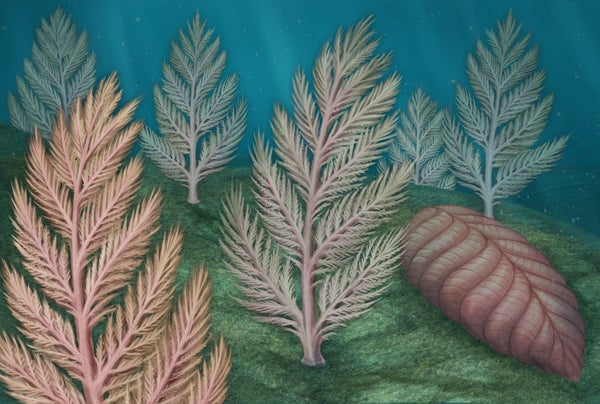Paleontologists unearthed a strange sight in Newfoundland in the early 2000s: an ancient fossil bed of giant, frond-shaped marine organisms. Researchers had discovered these mysterious extinct creatures—called rangeomorphs—before, but they continue to defy categorization. Now scientists believe the Newfoundland fossils and their brethren could help answer key questions about life on Earth.
Rangeomorphs date back to the Ediacaran period, which lasted from about 635 million to 541 million years ago. They had stemlike bodies that sprouted fractal-like branches and were soft like jellyfish. Scientists think these creatures grew to sizes until then unseen among animals—up to two meters long. After they went extinct, the planet saw an explosion of diverse large animal life during the Cambrian. “Rangeomorphs are part of the broader context of what was going on at this time in Earth's history,” says study co-author Jennifer Hoyal Cuthill, a paleobiology research fellow at the Tokyo Institute of Technology. Figuring out how rangeomorphs grew to such great sizes could help provide context for understanding how big, diverse animals originated and how conditions on Earth—which were shifting around this time—may have affected the evolution of life.
To better understand these connections, Hoyal Cuthill and University of Cambridge paleontologist Simon Conway Morris analyzed several rangeomorph fossils. The pair performed a micro CT scan on one well-preserved fossil of a species called Avalofractus abaculus, found in Newfoundland, to examine its 3-D structure in fine detail. They also took photographic measurements of two other specimens for comparison.
On supporting science journalism
If you're enjoying this article, consider supporting our award-winning journalism by subscribing. By purchasing a subscription you are helping to ensure the future of impactful stories about the discoveries and ideas shaping our world today.
The researchers examined various aspects of the rangeomorphs' stems and branches, then used mathematical models to investigate the relation between the fossils' surface areas and volumes. Their models, combined with the fossil observations, revealed that the organisms' size and shape appeared to be governed by the amount of available nutrients, according to the study, published recently in Nature Ecology & Evolution. This may explain why they could reach such large sizes during a period when Earth's geochemistry was changing.
But other experts are hesitant to generalize in this way. “This is an interesting finding that supports the growing consensus among researchers that rangeomorphs had the potential to grow differently in response to their environment,” says Jack Matthews, a research fellow at the Oxford University Museum of Natural History, who was not involved in the work. But “it is perhaps premature for this study to apply its finding to all rangeomorphs.”
If the explanation turns out to be correct, though, Hoyal Cuthill says, it could provide an answer for “what links this amazing appearance of larger organisms in the fossil record with [what was] happening on Earth.”
